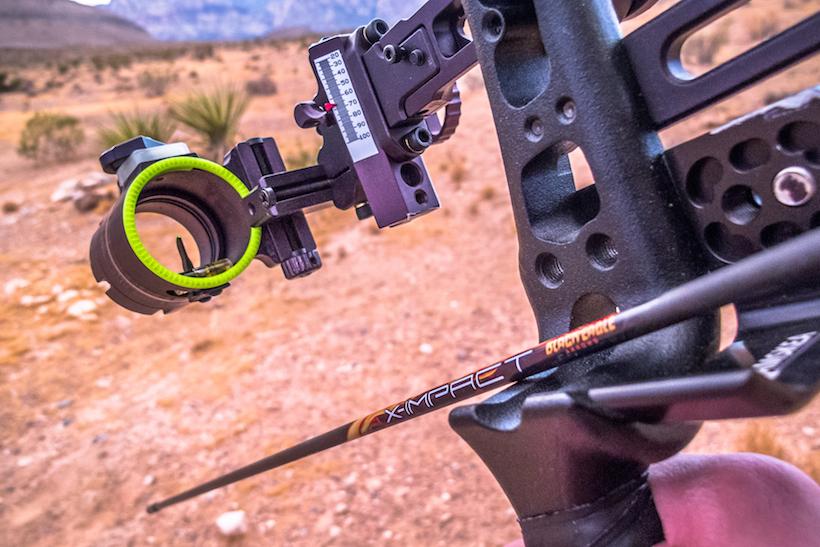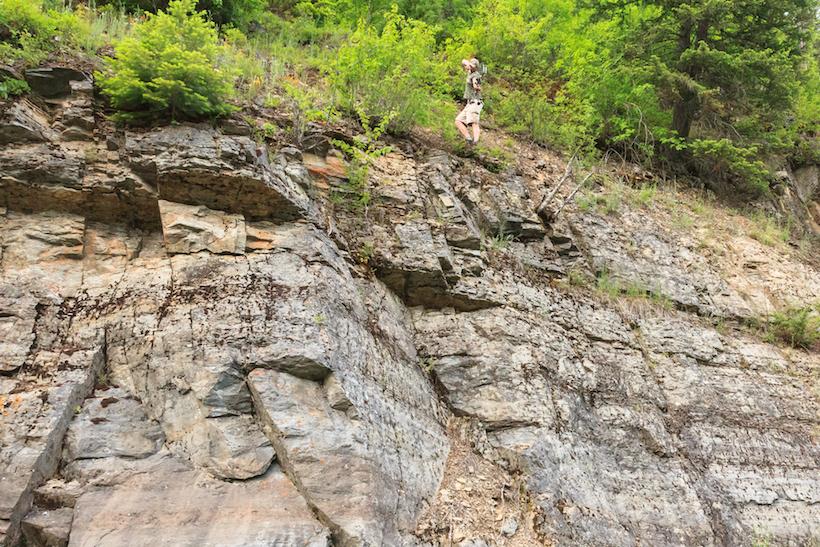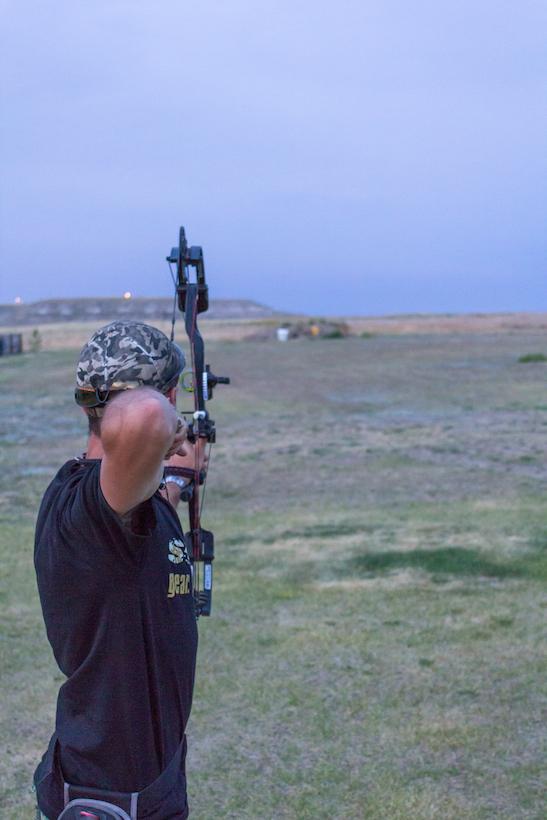




Utilizing a sight tape will make you a more accurate bowhunter. Practice adjusting the sight tape for the fast paced hunting situations. Photo credit: Brady Miller, goHUNT.com

Archery tournaments and long-distance competitions are a great way to develop skills that can enhance your shooting. Photo credit: Brady Miller, goHUNT.com

Practicing steep angles and in-the-field conditions will help your short and long range accuracy. Photo credit: Brady Miller, goHUNT.com

My friend Tim Ostlie is shown here practicing at 100 yards before we head out the next morning for an antelope hunt.
Looking to improve your long-range bow shots? Today’s advances in bow technology and performance make shooting over 40 yards with accuracy an achievable goal, though it still requires the right equipment and lots of practice. Here are eight ways to assist you in shooting longer ranges and successfully complete those long-distance shots.
A compound bow randomly selected right off the shelf is unlikely to be the right fit for your body. Take the time to test out a variety of bows. Look for a bow that’s accurate, fast, quiet and feels good in your hand. Select a bow that is near the peak weight you intend to shoot. If you want to shoot at 60 pounds, then select a 50-60 pound bow. Bows are made from the manufacturer to shoot more efficiently at the peak weight they are designed for. A bow that is setup for 60-70 pounds will not shoot as efficiently at 60 pounds as it would at 70 pounds. Users may not notice this benefit this at closer ranges, but it does come into play when you stretch the differences.
Keep in mind that the higher the draw weight, the harder the bow may be to hold at full draw. Strength training may be needed to develop muscles that can handle that weight. A quick test would be to draw the bow back smoothly through the draw cycle. If you have to raise the bow to the sky to draw or you need to quickly draw the bow back, then chances are the bow is too much for you. Also, you should be able to hold the weight at full draw for at least a minute without noticeable movement in your pin.
Choose a quality sight with pins that can accommodate your long-range shots. Moveable sights with a single pin are a good choice for most bowhunters looking to practice at a longer range. The precision these sights offer in yardage adjustments, along with their clear sight picture is excellent for shooting at a longer range.
A magnification lens in the scope housing can be another useful addition to a bow, giving the hunter 2x through 8x magnification, depending on the model. Check your local hunting regulations to make sure they’re legal in your state. Keep in mind that they have serious downfalls when hunting in the rain and shooting towards the sun.
A smaller peep sight can also be useful for accuracy at long distances, but makes it hard to see your pin in low-light conditions. Tinker with peep sizes and aiming adjustments to find what works best for you when shooting longer distances.
Rangefinders are another essential tool for shooting at longer ranges. Not only do they take the guesswork out of yardage estimation between you and that buck, they are also excellent for practicing shots at the specific distances you’ll likely face during hunting season. Select a rangefinder that can measure and compensate for slope (or be prepared to do those calculations on your own). It’s unlikely that you’ll be only taking flat shots in the field if you’re bowhunting out west.
Another essential for long-range shots is a sight tape calculated for your bow speed, particularly when using single pin sights. Software programs such as Archer’s Advantage and TAPes by The Archery Program are the most accurate choices to build customized sight tapes. Don’t feel like having a computer do the math? Shoot through a chronograph to get your arrow speed and use the sight tapes provided by your sight manufacturer instead.
We can’t emphasize this aspect of bowhunting enough: practice, practice, practice. You must pick up your bow at least few months before the start of the season, especially when trying to extend your range. Practice shots that are 40-50 yards farther than your goal; if you can create a tight cluster at 90 yards, 50 yards will be no problem. Once I get my bow dialed in at the house, most of my practice sessions will be 80 yards and further during the summer months. I will start at the longest distance so I won't be fatigued when I finally practice at longer distances. While I may not take a shot at those longer distances while hunting; it will create the confidence I need, plus help fine-tune my form.
Dedicated bowhunters shoot a few arrows a day year round to keep muscle memory keen and skills honed. Blind bale shooting (shooting a target at point-blank range without aiming at a particular spot) is great for practicing shot technique and focusing on your form since even minor flaws in execution will greatly impact long-range shots.
The rush a hunter feels out in the field is difficult to duplicate, no matter how many targets get hit in the yard. Practice real hunting situations and get your heart rate up by running from the target back to the spot you will shoot from. Shooting down a mountainside requires you to cut yardage, but practicing with your sight tape means that you’ll know where you need to set that pin for an accurate shot. Set up a target down a mountainside and practice shooting downhill into the wind. The more comfortable you are in accurate hunting conditions, the better you’ll be at knowing which shots to take. This is especially true when extending your range.
Another easy addition to your practice routine is to wear your gear. Shoot in the layers of insulated gear you’ll be wearing on the hunt as well as in your gloves, hat and other head coverings. Accuracy issues in the field often are a simple matter of getting used to what your bow feels like when you’re bulked up, not just in your street clothes.
When talking a long range shot in the field, the method I prefer would be to shoot from a kneeling position. It gives a solid platform and keeps your center of gravity low, especially when shooting down the side of a steep mountain. An elk or deer will likely spook if they see you taking a standing shot in the open, so vary your practice positions in the off-season. The same goes when using a treestand.
When practicing, work in wind similar to your hunting conditions. Altitude will make an arrow travel farther, so make sure to take some practice shots in order to calibrate your range before going after your quarry. Although flat ground is the most ideal, all that practice you’ve done learning how to float your arrow to compensate for strong wind and slope change will now truly pay off. Locate an area near your town where you can create difficult shot scenarios (windy, steep terrain, brush, etc.).
When shooting at longer ranges, broadside is the best, though quartering-away also offers the opportunity for a clean harvest. For best results, remember to hold your position until the arrow meets your target; follow-through is very important for long-range success.
Whether you’ve been shooting for years or just getting started, be honest about your personal ability when you get out into the field.
To make a long range shot count everything needs to be perfect; your form, your bow, the wind, etc. The way I like to perfect my form is to shoot at 100 plus yards. You can practice your form all day in your basement ... but form flaws show themselves at longer ranges. For example, I can torque my bow very hard at 30 yards and still hit the target and make a kill shot...so I wouldn't know I had bad form unless I stretched out the distance. Then I could correct that torqued bow form...and would eventually shoot better at all distances under pressure situations.
My friend Tim Ostlie is shown here practicing at 100 yards before we head out the next morning for an antelope hunt. Photo Credit: Brady Miller, goHUNT.com
Practicing at long distances will make shorter range shots cleaner and stronger as well as increase your possible shots when on the hunt. Know your max effective range and keep in mind that bowhunting is about getting close to animals.
Is long range bowhunting ethical? Check out this article.